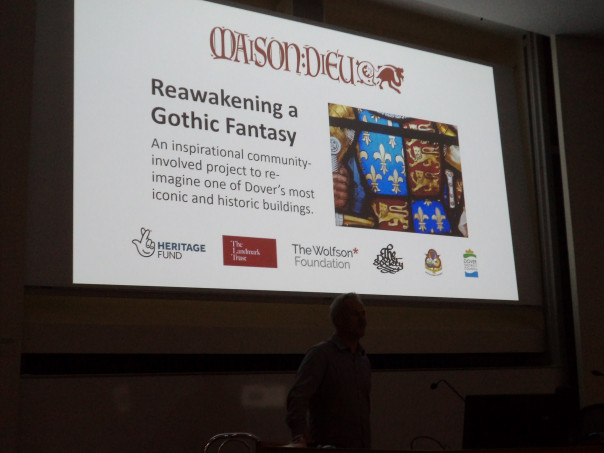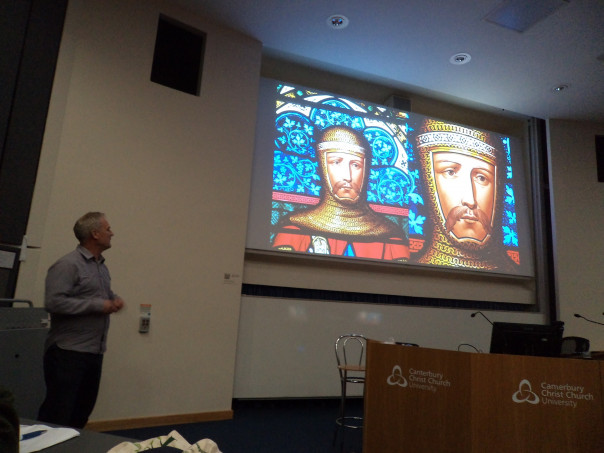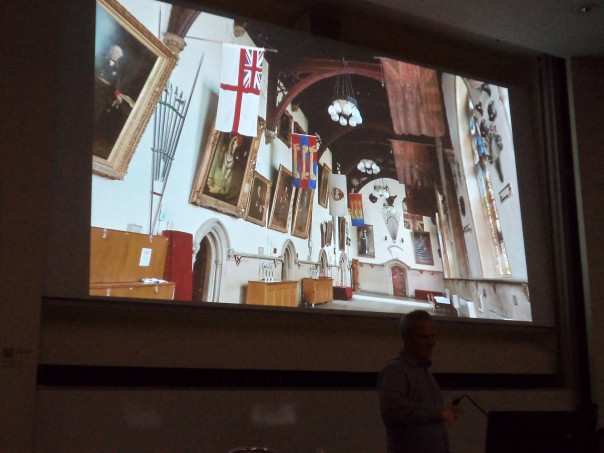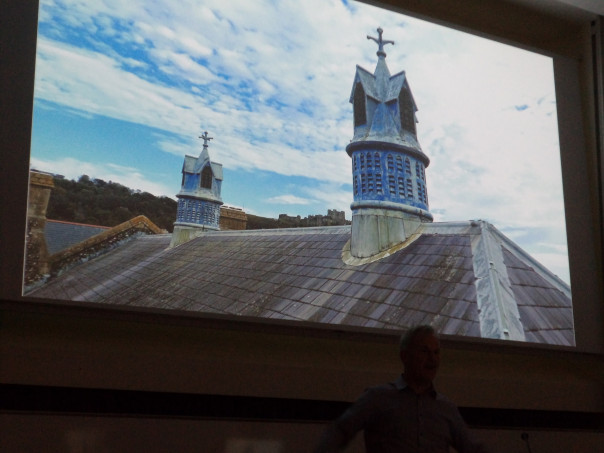This week the focus is Dover, and specifically the Maison Dieu, but before I get to that, I thought I would just mention a few other matters involving the CKHH.
Firstly, last Thursday Drs Claire Bartram and Diane Heath joined me in a discussion with Dr Sarah James, who is leading the St Dunstan’s church ‘Big Plan’ project, about how students and staff in CCCU Humanities might get involved in this exciting research and educational outreach opportunity. This will give us a chance to build on the links we already have, partly from years ago when I ran a study day on ‘Living through the Reformation’ at the church and hall as part of a Kent Archaeological Society initiative, and more recently our series of lectures on ‘Kentish Saints and Martyrs’, as well as the work of two students: Beth Woljung (History undergraduate) and Miranda Owens (MEMS postgraduate) who have researched and designed a series of educational pop-up banners for the church.

Secondly, this Thursday is the next Lossenham Project wills group meeting at Lossenham where the volunteers have an opportunity to plan the next sections of the wills project, building on the success of the Study Day last September. Moreover, this will be the first in person for a couple of recent recruits who have just completed a series of online palaeography workshops with me, another joint initiative with KAS because many of the others who came to these are members of the KAS Local History Societies’ Forum.
Thirdly, Diane’s 2nd ‘Amulets’ event will take place at the Science Museum in London on Monday 28 November. Again, the focus will be conversations among the various experts who are attending, as well as presentations by Drs Kathleen Walker-Meikle, Vicki Blud, Lucy Allen, Catriona Cooper (CCCU) and Diane. This is another exciting development as they work towards putting together an application to the AHRC.
Fourthly, Dr Doreen Rosman, an Associate of CKHH, will be launching her new book on the history of Canterbury. Entitled, Canterbury a History since 1500: a story of a city and its people, Doreen is having a book launch on Tuesday 22 November at 2.30pm in St Peter’s Methodist church. At this event, she will give a talk and there will be copies for sale at the discount price of £17 (cash or cheques only). Do go along if you are free and interested.

Now back to Dover, and firstly I want to report on the presentation as the 2nd event in the joint autumn programme of FCAT and CKHH. This was given by Martin Crowther, the Maison Dieu’s engagement officer for the over ten-million-pound project that is currently taking place there – incredibly exciting!! As Martin said, the building and its facilities need bringing up to date in different ways, for example, a considerable amount of conservation is also required, and as well as research and educational aspects to the project, it needs to be given new uses, both as commercial and community assets for the town and more widely. For while the building has been adapted in lots of different ways over the centuries, there might be said to be three crucially different phases to its history, all of which can be seen to varying degrees in today’s structure. All of this has allowed Martin to build a hundred plus group of volunteers, to work with a wide range of different educational and community groups, from primary schools to the local FE college and CCCU, the latter involving students on the second-year undergraduates as part of the Applied Humanities module option under Dr John Bulaitis (History).
Through his great slide presentation, Martin took us around the building, which was especially good for those who had been on Martin’s guided tour of the building last summer. We started in the Stone Hall, which had been built in the very late 13th century. Indeed, recent archaeological excavations of a ‘lost’ medieval street level door have revealed over 60 fragments of stained glass from the original windows that stained-glass experts have individually confirmed come from c.1300. There is also Caen stone window tracery which has gone pink, thereby demonstrating that it was damaged in the fire of 1789. Currently, the Stone Hall is largely full of scaffolding but within it there is a space where some conservation of various fixtures and fittings can take place.

Thinking about Hubert de Burgh’s original pilgrim hospital from the first decades of the 13th century, the infirmary hall has long gone and I’ll come to what is in its place in a moment, but the chapel does survive including features to work out about doors and windows, albeit considerably changed in later centuries. Also surviving from the medieval hospital is the western tower. As a point of interest, it was not solely poor pilgrims who were accommodated at the hospital, but also corrodians, generally aged royal retainers, but as at Ospringe the house also provided hospitality for royal officials, generally from the exchequer while other sections of the royal retinue were accommodated at Dover castle and Dover priory.
Moving on in time, the hospital after the Dissolution (and seemingly even before) was used as a royal store for the new harbour works and then as the royal victualling yard. The Stone Hall became the bread-making factory and the place housed great ovens for the making of ship’s biscuit as Dover’s Maison Dieu functioned as the smallest of five victualling centres as part of naval centres through to 1830. Moreover, from the 1660s next door was the brick-built home and office of the agent victualler. This aspect of the place’s history is marked in several ways, not least the regimental colours of the two local volunteer regiments from the time of the Napoleonic wars. These as you imagine are exceedingly fragile and once royal permission has been gained will be conserved. The conservation project will also encompass the arms and armour in the tower and the many royal portraits around the building.
Returning to the building, after its life as a victualling centre, it was acquired in the late 1830s by Dover council and it became the town hall, thereby replacing the earlier town hall in the marketplace near the ancient church of St Martin-le-Grand. There was money in Dover in the 19th century and the ‘new’ town hall was massively extended, there being two main campaigns: the reconstruction and repurposing of the Stone Hall and the construction of the Connaught Hall, the first being an early William Burges, following on from Ambrose Pointer, project, of the 1850s, the latter being a late, end of career project for Burges in the 1880s. As you would expect from Burges the Stone Hall is full of very high quality neo-Gothic architecture, including fixtures and fittings, based on his research in France and Italy. Additionally, it has some incredibly interesting secular stained glass, depicting scenes from the town’s history, such as the siege of Dover castle of 1216 and Henry VIII and the Field of the Cloth of Gold, which was the work of Edward Pointer.

Moving to the Connaught Hall next door, it highlights other aspects of Burges’ talents as a neo-Gothic architect and designer. There is the hall itself and the decorative scheme, which although painted over in 1967 has not been totally destroyed, and some of Burges’ work at least is being revealed by the conservators. Other Burges touches include the gaslight candelabra with crenelated castle fittings and an air circulation system. Elsewhere in the building there is a great Burges table made of American walnut and a set of lion-headed chairs, as well as carvings and other features in the Mayor’s Parlour and in the Council Chamber. Indeed, some of the chairs have not been touched since they were produced in 1893 and even though that means they are in a pretty poor state, they are rare museum pieces and will be treated as such by the project.
Further parts of the building that Martin touched upon were the conversion of the medieval chapel to a court room, cases still being heard there within living memory and that aspect is now the subject of an oral history project. To go with the court was Dover’s Victorian prison, the 40 cells still surviving underneath, and once the project’s work on the building has been completed, these will feature as part of the occasional guided visits on Heritage days.
Hopefully you can tell from this just what a gem this building is, and during the project, as well as beyond, it is and will be used for craft activities, research projects and other events by schools, colleges and community groups. Additionally, part will be taken by the Landmark Trust as a place for people to stay, thereby generating revenue, and similarly there will be a cafe and some of the rooms will be available for hire.
Having taken us on a tour around the Maison Dieu, Martin took questions from the audience, as well as comments about how much people had enjoyed his presentation. So ended a highly successful meeting and it will be great to see the place when it reopens in 2025.

Keeping with Dover, Kieron Hoyle has recently begun her doctorate on the role of the Maison Dieu in Tudor and early Stuart Dover, investigating especially its role in the provision of the new harbour works and its position in the triangle of town, Crown and Maison Dieu. This is supported by the Janus Foundation in association with the ‘Kent’s Maritime Communities’ project via the Ian Coulson Postgraduate Fund. Consequently, very much as a ‘work in progress’, Kieron gave a presentation to the Kent History Postgraduates this week. She began by outlining the place’s medieval history before moving to the hospital’s penultimate and last masters, both of whom were heavily involved in the provision of a harbour at Dover. Through a series of diagrams, Kieron outlined the early harbour developments or attempts to keep the harbour free from deposits of sand and shingle, brought through factors such as longshore drift, a feature of many Kent ports due to the prevailingly westerlies and the actions of the tides.
Thus, much of Kieron’s presentation focused on the different schemes that were tried with varying levels of success over the 16th century to produce a functioning harbour for ocean-going shipping. Of the Tudor monarchs, Henry VIII was perhaps the most enthusiastic, and his government threw large sums at these harbour works, whereas Elizabeth his daughter, although less enthusiastic (and not inclined to devote the same levels of cash on it), witnessed the provision of more successful schemes overall. Kieron went through all of these various plans and discussed the main people involved in each, as well as some ideas about the general socio-political situation. Moreover, as she noted, for the town this had all become too difficult for the civic authorities by 1606, the authorities negotiating an agreement with the Crown for it to take on the harbour.

During her presentation, Kieron also discussed the various sources that she has looked at briefly and what she is compiling by way of materials that she will need to consult. To make this more manageable, she is going to compile a database because network analysis appears to be an important part of this project. Currently, she is also undertaking a great deal of secondary reading as a means to gain a good grasp of Dover in this period and how it fits into the development of England’s naval provision during the early modern period. She sees that there were certain occupational groups who were key players during this formative period, and in part this will frame her research.
Kieron’s presentation drew several questions, suggestions and comments from those in the room and from those online, and even though we did not have time for a long discussion, hopefully it was useful, not least ideas about what was happening at other naval yards around the southern and eastern seaboard, and the implications for social relations between the Elizabethan idea of society comprising the governors and the governed. Thus, there are obvious parallels with other doctoral projects being undertaken by others within the group.
Next week as you can see from the start there are plenty more events and other matters coming up, so watch this space!
 Centre for Kent History and Heritage
Centre for Kent History and Heritage Sheila Sweetinburgh
Sheila Sweetinburgh 1381
1381

